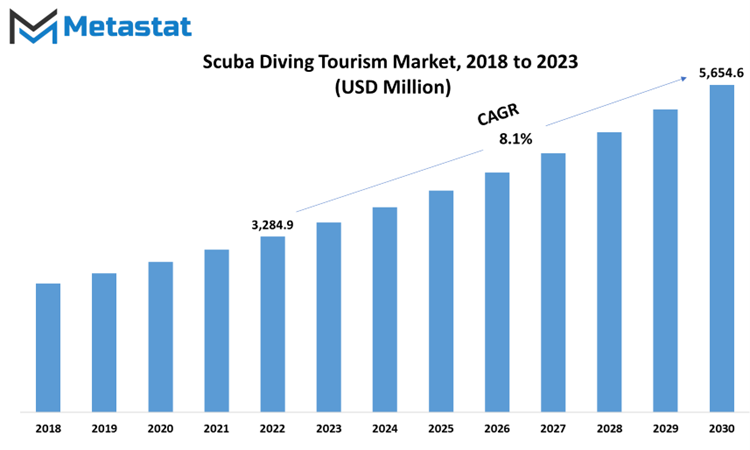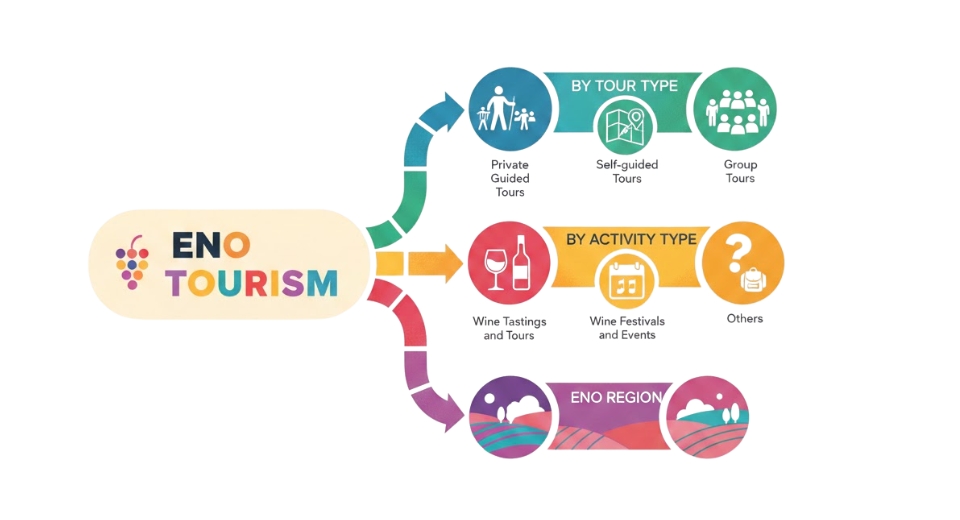MARKET OVERVIEW
The Global Scuba Diving Tourism market is a vibrant and dynamic segment within the global tourism industry, offering individuals the opportunity to explore the underwater world and witness the marvels of marine ecosystems. Scuba diving tourism seamlessly blends adventure, exploration, and the allure of natural beauty, drawing a diverse array of travelers in search of unique and immersive experiences. Scuba diving, a recreational pursuit involving underwater exploration with specialized breathing equipment, enables divers to delve into breathtaking coral reefs, encounter a plethora of marine species, and behold the enchanting landscapes concealed beneath the ocean's surface. From vibrant coral gardens to hidden underwater caves and sunken shipwrecks, the underwater realm boasts an array of attractions and encounters that captivate the imaginations of adventurers and nature enthusiasts alike.
The Scuba Diving Tourism market is propelled by the burgeoning interest in adventure tourism and water-based activities. Modern-day travelers increasingly yearn for distinctive and engaging experiences that transcend traditional sightseeing and passive vacations. Scuba diving, with its inherent excitement and intimate interaction with marine life, impeccably aligns with the desires of adventure-seeking individuals. The opportunity to plunge into an entirely different environment, explore uncharted territories, and bear witness to the sheer beauty of underwater ecosystems constitutes a major allure for tourists.
One of the market's distinguishing features is the extensive array of diving destinations available worldwide. Spanning from tropical coastal regions teeming with vibrant coral reefs, such as Australia's Great Barrier Reef or the Maldives, to cold-water locales boasting remarkable marine life, like California's kelp forests or Norway's fjords, there exist diverse options catering to divers of all preferences and experience levels. Each destination offers its own unique underwater landscapes, distinct marine ecosystems, and cultural experiences, ensuring an expansive selection for travelers seeking scuba diving adventures.
Crucially, the Scuba Diving Tourism market is buttressed by a well-connected network of dive centers, tour operators, and experienced diving instructors who facilitate and coordinate these unforgettable diving experiences. Global Scuba Diving Tourism market is estimated to reach $5,654.6 Million by 2030; growing at a CAGR of 8.1% from 2023 to 2030.

GROWTH FACTORS
In Scuba Diving Tourism, a remarkable surge is unfolding, propelled by the burgeoning fascination with adventure-oriented tourism and aquatic endeavors. Contemporary voyagers are in pursuit of extraordinary and exhilarating escapades, veering away from conventional sightseeing and passive holidaying. The realm of scuba diving seamlessly aligns with their yearning for immersive exploits. Social media and digital platforms have assumed a pivotal role in this phenomenon, as influencers and travel connoisseurs disseminate enthralling subaquatic content, thereby igniting the wanderlust of globetrotters on a global scale. Enhanced accessibility has been made attainable through cutting-edge gear and safety protocols, rendering scuba diving an even more enticing prospect for neophytes. The proliferation of certification programs has bolstered self-assurance, attracting a broader spectrum of enthusiasts. Furthermore, the growing emphasis on marine conservation resonates deeply with conscientious travelers who harbor concerns for the environment, thereby further propelling the Scuba Diving Tourism sector. In summary, the burgeoning Scuba Diving Tourism market can be attributed to the evolving preferences of travelers, the influential sphere of social media, advancements in equipment, and a resolute commitment to sustainability. These factors collectively contribute to making scuba diving a highly sought-after activity within the realm of adventure tourism.
MARKET SEGMENTATION
By Diving Type
The global Scuba Diving Tourism market is a dynamic industry that caters to divers with varying interests and preferences. To cater to the diverse needs of divers, the market is segmented into several diving types, each offering a unique and distinct underwater experience. These segments include Drift Diving, Deep Diving, Wreck Diving, and other specialized forms of diving. In this essay, we will elaborate on each of these diving types to provide a comprehensive understanding of the global Scuba Diving Tourism market
Drift diving is an exhilarating form of underwater exploration where divers allow themselves to be carried by ocean currents. Unlike traditional diving where divers swim against or stay stationary in the current, drift diving involves going with the flow. This type of diving is characterized by a sense of weightlessness as divers effortlessly glide through the water, observing the vibrant marine life and coral formations that pass by. It offers a unique opportunity to cover large distances underwater, making it a favorite choice for those seeking adventure and a closer connection with the natural movement of the sea.
Deep diving is an advanced form of scuba diving that takes divers to greater depths below the surface. It requires specialized training and equipment due to the increased pressure and potential risks associated with diving at greater depths. Deep divers are drawn to explore the mysterious and less-explored realms of the ocean, where they can encounter unique species of marine life and geological formations and the market for it will be 2309.5 USD Million in 2030. The sense of awe and wonder that comes from descending into the depths of the ocean is a powerful attraction for those who choose deep diving as their preferred diving type.
Additionally, Wreck diving is a fascinating subcategory of scuba diving that involves exploring sunken ships, aircraft, or other man-made structures that have found their final resting place on the ocean floor. These underwater wrecks often serve as artificial reefs, providing sanctuary to a rich diversity of marine species. Wreck divers are drawn to the historical and archaeological aspects of these sites, as they can offer a glimpse into the past and a chance to uncover hidden stories of maritime history. This type of diving allows divers to combine their passion for exploration with their interest in history, making it a unique and rewarding experience.
Last, is the others category in the Scuba Diving Tourism market that includes various specialized diving types that cater to niche interests within the diving community. The Others segment was valued at 395.6 USD Million in 2022. Each of these diving types offers a distinct set of challenges and rewards. Cave divers, for example, explore intricate underwater cave systems, while ice diver's brave frigid waters to witness the unique beauty of ice formations below the surface. Night divers, on the other hand, experience a different world underwater when nocturnal marine life becomes active. These specialized forms of diving attract enthusiasts who are passionate about their chosen niche and seek to expand their underwater horizons.

By Tourist Type
The global Scuba Diving Tourism market, when examined by tourist type, is intricately subdivided into two key segments: domestic and international. Each of these segments represents a distinct facet of the scuba diving tourism industry, catering to different sets of travelers with unique motivations, preferences, and characteristics.
The first segment, domestic scuba diving tourism, encapsulates the experiences and activities undertaken by individuals within their own country's borders. Domestic scuba diving enthusiasts often seek out underwater adventures and exploration opportunities without venturing far from home. The Domestic segment was valued at 1182.5 USD Million in 2022 and accounted for 38.5% of Scuba Diving Tourism Market in 2022. This segment is characterized by divers who may visit nearby lakes, rivers, or coastal regions to indulge in their passion for scuba diving. These divers are typically looking for convenient and cost-effective options, as their travel distances are relatively shorter compared to international tourists. Furthermore, domestic scuba diving tourism may also include individuals who engage in the sport regularly as a hobby or for leisure, often exploring familiar underwater ecosystems and marine life. This segment contributes significantly to the local economies of coastal and diving-centric regions, fostering a sense of environmental responsibility and stewardship among domestic divers.
On the other hand, international scuba diving tourism represents a more diverse and expansive subset of the market. This segment comprises travelers who cross international borders in pursuit of unique and exotic diving experiences. International scuba divers are motivated by the allure of exploring different underwater environments, encountering diverse marine life, and immersing themselves in various cultures. They may travel to tropical destinations like the Maldives, Fiji, or the Great Barrier Reef in Australia, or opt for colder waters in places like Iceland or Norway for cold-water diving adventures. International divers often invest significant time and resources in planning their trips, seeking out specialized dive operators and resorts that offer world-class diving experiences and it will be 3539.2 USD Million in 2030. These travelers are more likely to have advanced diving certifications and extensive experience, making them a crucial clientele for the global scuba diving tourism industry.
REGIONAL ANALYSIS
Scuba diving is a thrilling and immersive underwater activity that has gained immense popularity among adventure enthusiasts and nature lovers. It offers a unique opportunity to explore the mesmerizing world beneath the waves, teeming with vibrant marine life and stunning coral reefs. The global scuba diving tourism market is segmented by geography, and North America and Europe hold significant shares in this exciting industry.
North America, comprising the United States, Canada, and Mexico, is a prominent player in the scuba diving tourism market, contributing to approximately 24.7% of the total market share in 2022. Each of these North American countries offers distinct scuba diving experiences due to their diverse marine ecosystems and geographical features. The United States, with its extensive coastline along both the Atlantic and Pacific Oceans, boasts an abundance of dive sites, ranging from the tropical waters of Florida and Hawaii to the kelp forests of California.
Canada, on the other hand, offers unique cold-water diving experiences, with its pristine lakes, fjords, and coastal waters. Divers can encounter diverse marine life, including giant kelp forests, sea otters, and the elusive giant Pacific octopus. Mexico, with its stunning Caribbean and Pacific coasts, is renowned for its crystal-clear waters and vibrant coral reefs.
Moving across the European scuba diving tourism market, estimated to be valued at 1455.7 USD Million in 2018. Europe offers a rich variety of diving experiences, thanks to its diverse coastal regions and Mediterranean climate. The key players in European scuba diving tourism include the United Kingdom, Germany, France, Italy, and other European nations. The United Kingdom may not boast tropical waters, but it is famous for its shipwrecks and rich maritime history. Diving enthusiasts flock to destinations like Scapa Flow in Scotland to explore sunken warships, while the waters off the south coast are home to colorful marine life and underwater caves.
COMPETITIVE PLAYERS
The Scuba Diving Tourism industry encompasses a rich tapestry of dive types, catering to a diverse range of interests and skill levels. From recreational diving in tropical paradises to the adrenaline rush of extreme dives, each type offers a unique perspective on the underwater world. Key players in the industry, such as Natural Travel Collection Ltd., PADI Travel, Dive-The-World.com, Fly & Sea Dive Adventures, Ultimate Dive Travel, Island Expeditions Company Limited, Project Expedition, Scuba Travel, Bluewater Travel, and Divers Den, play pivotal roles in facilitating these unforgettable experiences. Scuba diving tourism not only provides thrilling adventures but also fosters a deeper connection with the marine environment, contributing to its conservation and protection for future generations.
Scuba Diving Tourism Market Key Segments:
By Diving Type
- Drift Diving
- Deep Diving
- Wreck Diving
- Others
By Tourist Type
- Domestic
- International
Key Global Scuba Diving Tourism Industry Players
- Natural Travel Collection Ltd.
- PADI Travel
- Dive-The-World.com
- Fly & Sea Dive Adventures
- Ultimate Dive Travel
- Island Expeditions Company Limited
- Project Expedition
- Scuba Travel
- Bluewater Travel
- Divers Den
WHAT REPORT PROVIDES
- Full in-depth analysis of the parent Industry
- Important changes in market and its dynamics
- Segmentation details of the market
- Former, on-going, and projected market analysis in terms of volume and value
- Assessment of niche industry developments
- Market share analysis
- Key strategies of major players
- Emerging segments and regional growth potential








 US: +1 3023308252
US: +1 3023308252






